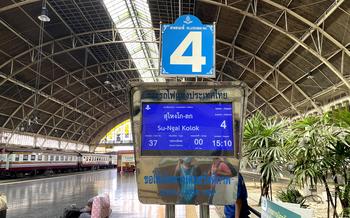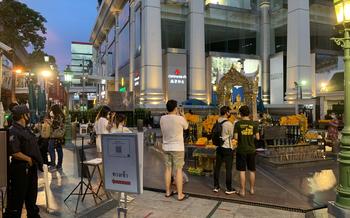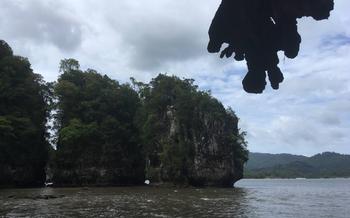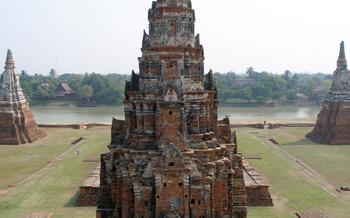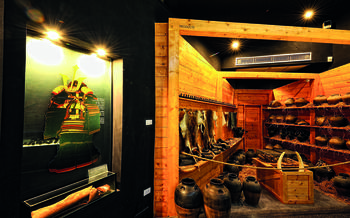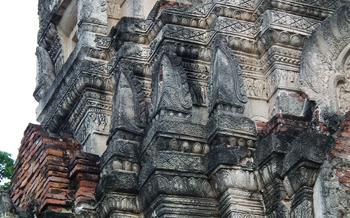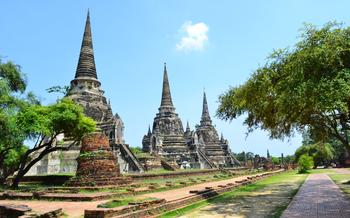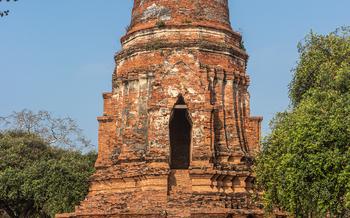
Namtok Sam Lan National Park
- History and significance of the park
- Waterfalls: The Park's Main Attraction
- Exploring Nature Trails and Viewpoints
- Caving Adventures in Sam Lan National Park
- Camping and Accommodation Options
- Picnicking and Dining in Nature
- Cultural Experiences and Local Communities
- Best Time to Visit Sam Lan National Park
- Getting to Sam Lan National Park
- Navigating Transportation Options
- Guided Tours and Local Guides
- Photography Opportunities
- Eco-Friendly Practices
- Packing Essentials
- Insider Tip: Hidden Gems and Off-the-Beaten-Track Adventures
History and significance of the park
Established in 1981, Namtok Sam Lan National Park encompasses a stunning 210 square kilometers of lush forests, cascading waterfalls, and fascinating caves. Its name, meaning "Three-Level Waterfall", derives from the park's main attraction - the magnificent Namtok Sam Lan waterfall. The park holds immense ecological significance, harboring a diverse array of flora and fauna, including endangered species like the Asiatic black bear and Siamese crocodile. Namtok Sam Lan National Park serves as a vital sanctuary for these precious creatures, contributing to the conservation of Thailand's rich biodiversity.
Waterfalls: The Park's Main Attraction
Namtok Sam Lan National Park is home to an impressive array of stunning waterfalls, each offering a unique and breathtaking spectacle. The park's namesake waterfall, Namtok Sam Lan, is a three-tiered cascade that plunges over a sheer cliff, creating a mesmerizing sight. Its crystal-clear waters cascade into a pool below, inviting visitors to take a refreshing dip.
Another must-see waterfall is Namtok Pang Sra, a picturesque cascade surrounded by lush greenery. This waterfall is known for its gentle flow and serene atmosphere, making it a perfect spot for relaxation and contemplation.
For those seeking a hidden gem, Namtok Huai Sai is an off-the-beaten-track waterfall located in the park's remote corners. This secluded waterfall offers a tranquil escape, where visitors can immerse themselves in the sounds of nature and enjoy the beauty of the cascading waters.
Exploring Nature Trails and Viewpoints
Namtok Sam Lan National Park invites nature enthusiasts to embark on an unforgettable journey through its well-maintained trails, leading to scenic viewpoints that offer breathtaking vistas. These trails provide a perfect opportunity to immerse oneself in the park's rich biodiversity and capture the essence of its natural beauty.
The trails vary in difficulty levels, catering to hikers of all skill levels. Whether you prefer leisurely walks or challenging treks, the park offers a trail that suits your preferences. However, safety remains a top priority while exploring these trails. Proper footwear and adequate water are essential, and visitors should be mindful of potential hazards such as slippery surfaces and uneven terrain.
Along the trails, keep an eye out for the diverse wildlife that calls the park home. From colorful birds fluttering among the trees to shy animals scurrying through the undergrowth, there's always something to discover. Be patient and observant, and you might just catch a glimpse of a rare or endangered species.
Whether you're a seasoned hiker or a casual nature lover, the trails and viewpoints of Namtok Sam Lan National Park promise an enriching experience that will leave you in awe of the park's natural wonders.
Caving Adventures in Sam Lan National Park
Sam Lan National Park is a haven for cave enthusiasts, boasting several impressive caves with unique limestone formations. - Tham Nam Lot, the park's most popular cave, is a sight to behold. Visitors can explore the cave's vast chambers and marvel at the underground river that flows through it. - Tham Khao Bin, another must-see cave, showcases ancient rock paintings that provide a glimpse into the area's rich cultural heritage. Caving in Sam Lan offers a thrilling and educational experience, allowing visitors to discover the hidden wonders beneath the park's surface.
Before embarking on a caving adventure, safety should be a top priority. Visitors are advised to wear proper footwear and clothing, bring a flashlight or headlamp, and inform park rangers of their intended route. Cave exploration can be challenging, and it's crucial to be prepared for uneven terrain, tight spaces, and potential wildlife encounters. For a more enriching experience, consider hiring a local guide who can provide insights into the park's geology, history, and cave formations.
Camping and Accommodation Options
Namtok Sam Lan National Park offers a range of accommodation options for visitors who want to immerse themselves in the natural beauty of the park. Designated camping areas are available within the park, providing a unique opportunity to experience the tranquility of the forest under the starry sky. These campsites are equipped with basic facilities such as restrooms, showers, and cooking areas.
For those who prefer a more comfortable stay, several resorts and guesthouses are located near the park. These accommodations offer a range of amenities, including air-conditioned rooms, private bathrooms, and restaurants. Whether you choose to camp under the stars or stay in a cozy guesthouse, there are options to suit every budget and preference.
When choosing your accommodation, consider the following factors:
-
Camping: If you are an adventurous traveler who enjoys being close to nature, camping is a great option. Keep in mind that you will need to bring your own camping gear and supplies.
-
Resorts and guesthouses: These accommodations offer a more comfortable stay with amenities like air conditioning and private bathrooms. However, they tend to be more expensive than camping.
-
Location: Consider the proximity of your accommodation to the park entrance, waterfalls, and other attractions you plan to visit.
-
Budget: Accommodation costs vary depending on the type of accommodation, amenities, and location. Plan your budget accordingly.
Picnicking and Dining in Nature
Picnics in Paradise: Embrace the natural beauty of Sam Lan National Park with a delightful picnic amidst stunning scenery. Designated picnic spots offer breathtaking views, allowing you to dine in the heart of nature. Spread out a blanket, unpack your hamper filled with local delicacies, and savor the tranquility of your surroundings.
Local Flavors: Enhance your picnic experience by indulging in local culinary delights. Food stalls and restaurants near the park offer a variety of Thai dishes, from traditional favorites to refreshing beverages. Sample the region's specialties, such as spicy papaya salad or aromatic curries, and enjoy a taste of authentic Thai cuisine.
Picnic Essentials: To ensure a seamless picnic, pack all the essentials. Bring a cooler bag to keep your food and drinks fresh, as well as plates, utensils, and napkins to minimize waste. Don't forget a tablecloth or blanket for a comfortable seating arrangement.
Sustainable Dining: Embrace sustainable dining practices to protect the park's pristine environment. Avoid single-use plastics by bringing your own reusable containers and utensils. Properly dispose of waste in designated bins or carry it out with you to maintain the park's cleanliness.
Cultural Experiences and Local Communities
Sam Lan National Park offers a unique opportunity to connect with local communities and experience the rich cultural heritage of the region. Visitors can interact with friendly villagers who are proud to share their traditions, crafts, and stories. The park is home to several local markets where visitors can purchase traditional handicrafts, souvenirs, and local delicacies. These markets are a vibrant showcase of the region's unique culture and provide a glimpse into the daily lives of the local people.
In addition, visitors can participate in cultural events and festivals held throughout the year, which offer a chance to immerse themselves in the local way of life. These events often feature traditional music, dance, and cuisine, as well as opportunities to learn about local customs and traditions.
Respecting local customs and traditions is essential for a harmonious and enjoyable experience. Visitors should dress modestly, behave respectfully, and seek permission before taking photos of local people or their property. By embracing the local culture and interacting with the friendly communities, visitors can create meaningful connections and gain a deeper understanding of the region's rich heritage.
Best Time to Visit Sam Lan National Park
The best time to visit Sam Lan National Park is during the cool and dry season from November to February, when the weather is pleasant for outdoor activities, and the waterfalls are at their fullest. The park's natural beauty is enhanced by the lush green foliage and vibrant wildflowers during this time.
Avoid visiting during the hot and humid season from March to May, as temperatures can soar, making hiking and other outdoor activities less enjoyable. The waterfalls may also be less impressive during this time due to reduced water flow.
The rainy season from June to October brings heavy rainfall, which can make trails muddy and slippery. However, the park's lush vegetation and cascading waterfalls are at their peak during this time, creating a picturesque landscape.
If you're primarily interested in waterfall viewing, plan your visit during the rainy season when the waterfalls are most impressive. However, be prepared for potential rain and slippery conditions.
To avoid crowds and enjoy a more tranquil experience, visit the park during the weekdays. Weekends and public holidays tend to be busier, especially during the peak season.
Remember to check the park's website or contact local tourism offices for the most up-to-date information on weather conditions and park closures before planning your visit.
Getting to Sam Lan National Park
Navigating Transportation Options
Reaching Sam Lan National Park offers a range of transportation options, catering to the diverse preferences of travelers. For those based in Bangkok or nearby cities, convenient public transportation routes are available. Buses depart from the Mo Chit Bus Terminal in Bangkok, providing a direct connection to the park. Alternatively, trains from Hua Lamphong Railway Station offer a scenic journey to Saraburi province, followed by a short bus ride to the park.
Exploring the park at your own pace and immersing yourself in its natural beauty is made possible by renting a car. Rental agencies in Bangkok and Saraburi provide a variety of vehicles to suit your needs. Driving to the park offers the freedom to explore at your leisure and discover hidden gems along the way. For those seeking a more personalized experience, hiring a private driver is a great option. Professional drivers can be arranged through tour operators or directly at your hotel. They ensure a hassle-free journey, providing valuable insights into the region's history and culture.
To enhance your navigation, utilize GPS devices or online mapping applications. Key in the park's coordinates or search for "Namtok Sam Lan National Park" to receive precise directions. Road signs are generally well-marked, guiding you smoothly to the park's entrance. Embrace the adventure and embark on a journey to Sam Lan National Park, where nature's wonders await.
Guided Tours and Local Guides
Exploring Namtok Sam Lan National Park with a local guide offers an enriching and hassle-free experience. These knowledgeable individuals can provide insights into the park's history, geology, and biodiversity, enhancing your understanding and appreciation. Guided tours typically cover the park's highlights, including the stunning waterfalls, scenic viewpoints, and caves. They also ensure that you follow park regulations, prioritize safety, and minimize your environmental impact.
Local guides can customize tours based on your interests and fitness level, whether you prefer leisurely walks or challenging hikes. They can also recommend the best spots for wildlife viewing, photography, and picnicking. Booking a guided tour in advance is advisable, as they tend to fill up quickly during peak tourist seasons. Costs vary depending on the tour duration, group size, and inclusions. Choose a reputable tour operator with experienced and certified guides to ensure a safe and enjoyable experience.
Photography Opportunities
Namtok Sam Lan National Park offers a wealth of opportunities for photographers to capture stunning images of its natural beauty. With its diverse landscapes, cascading waterfalls, serene caves, and rich wildlife, the park is a photographer's paradise.
Waterfalls
The park's waterfalls are undoubtedly its most iconic subjects. Namtok Sam Lan, the park's namesake waterfall, is a sight to behold with its three tiers of cascading water. Namtok Pang Sra and Namtok Huai Sai are equally impressive, each with its unique characteristics. Photographers can capture the waterfalls from various angles, experimenting with different shutter speeds to create dramatic effects.
Caves
The park's caves offer a different kind of photographic challenge. With their intricate rock formations, stalactites, and stalagmites, the caves provide ample opportunities for creative photography. Tham Nam Lot, with its underground river, is a particularly popular spot for photographers. Tripods and flashlights are essential for capturing the caves' hidden beauty.
Wildlife
The park's diverse ecosystem supports a variety of wildlife, including birds, reptiles, and insects. Photographers with a keen eye can capture stunning shots of these creatures in their natural habitat. Patience and a telephoto lens are key to capturing wildlife photography.
Tips for Taking Stunning Photos
-
Use a tripod: A tripod will help you stabilize your camera and capture sharp images, especially in low-light conditions.
-
Experiment with shutter speeds: Varying the shutter speed can create different effects, such as blurring the water in waterfalls or freezing the movement of wildlife.
-
Use a polarizing filter: A polarizing filter can help reduce glare and reflections, resulting in more saturated colors and improved contrast.
-
Respect park regulations: Be mindful of park regulations regarding photography, such as the use of drones and flash photography in certain areas.
Eco-Friendly Practices
As a visitor to Sam Lan National Park, it is crucial to minimize your environmental impact and contribute to its conservation efforts. Embrace sustainable tourism practices by properly disposing of waste and utilizing recycling bins provided throughout the park. Support local businesses that prioritize sustainability, such as those offering eco-friendly tours or using biodegradable materials. Educate yourself about the park's conservation initiatives and actively participate in preserving its natural beauty. By adopting eco-friendly practices, you can help protect the park's delicate ecosystem for future generations while enjoying a responsible and fulfilling travel experience.
Packing Essentials
Dressing for the Occasion: Navigating the natural wonders of Sam Lan National Park requires appropriate attire and footwear. Opt for comfortable, breathable clothing suitable for hiking and outdoor activities. Sturdy shoes or hiking boots will provide the necessary support and traction on uneven trails and slippery surfaces.
Sun Protection: Thailand's tropical climate demands adequate sun protection. Pack a hat or scarf to shield your head and neck from the sun's harsh rays. Sunscreen is a must-have to prevent sunburn and protect your skin from prolonged exposure.
Hydration and Nourishment: Staying hydrated is crucial during your park adventures. Bring a reusable water bottle and fill it up at designated stations within the park. Pack sufficient snacks or energy bars to replenish your energy levels throughout the day.
Wildlife Spotting Gear: If you're an avid nature enthusiast, binoculars are a valuable tool for observing wildlife from a distance. Capture the beauty of your encounters by packing a camera to document the diverse flora and fauna you encounter.
Insider Tip: Hidden Gems and Off-the-Beaten-Track Adventures
Venture beyond the popular trails and discover the hidden gems of Sam Lan National Park. Seek out lesser-known waterfalls like Namtok Pha Prang, a secluded cascade with a refreshing plunge pool. Explore nearby caves such as Tham Khao Ngam, home to impressive stalactites and stalagmites. These hidden treasures offer a tranquil and serene experience, away from the crowds.
For a taste of local culture, visit the nearby villages and markets. Interact with the friendly locals, learn about their traditions, and sample delicious regional cuisine. Indulge in fresh fruits, local delicacies, and mouthwatering street food. By venturing off the beaten path, you'll gain a deeper appreciation for the park's diverse ecosystems and the vibrant communities that surround it.
